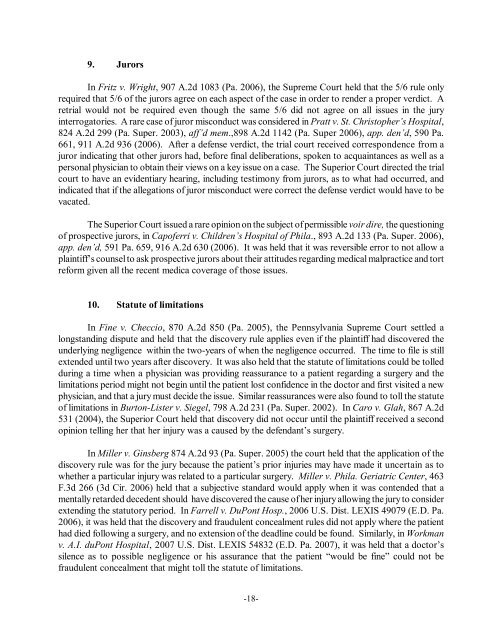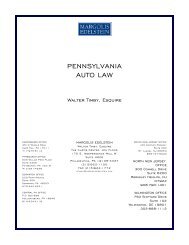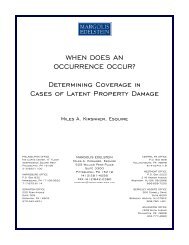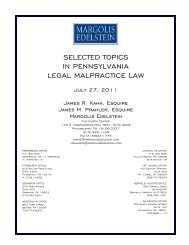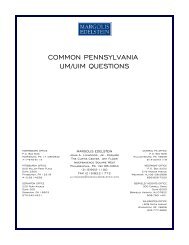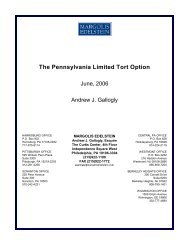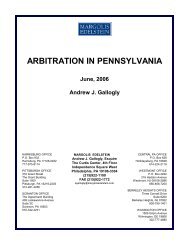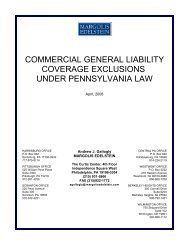recent developments in pennsylvania medical malpractice law
recent developments in pennsylvania medical malpractice law
recent developments in pennsylvania medical malpractice law
You also want an ePaper? Increase the reach of your titles
YUMPU automatically turns print PDFs into web optimized ePapers that Google loves.
9. JurorsIn Fritz v. Wright, 907 A.2d 1083 (Pa. 2006), the Supreme Court held that the 5/6 rule onlyrequired that 5/6 of the jurors agree on each aspect of the case <strong>in</strong> order to render a proper verdict. Aretrial would not be required even though the same 5/6 did not agree on all issues <strong>in</strong> the jury<strong>in</strong>terrogatories. A rare case of juror misconduct was considered <strong>in</strong> Pratt v. St. Christopher’s Hospital,824 A.2d 299 (Pa. Super. 2003), aff’d mem.,898 A.2d 1142 (Pa. Super 2006), app. den’d, 590 Pa.661, 911 A.2d 936 (2006). After a defense verdict, the trial court received correspondence from ajuror <strong>in</strong>dicat<strong>in</strong>g that other jurors had, before f<strong>in</strong>al deliberations, spoken to acqua<strong>in</strong>tances as well as apersonal physician to obta<strong>in</strong> their views on a key issue on a case. The Superior Court directed the trialcourt to have an evidentiary hear<strong>in</strong>g, <strong>in</strong>clud<strong>in</strong>g testimony from jurors, as to what had occurred, and<strong>in</strong>dicated that if the allegations of juror misconduct were correct the defense verdict would have to bevacated.The Superior Court issued a rare op<strong>in</strong>ion on the subject of permissible voir dire, the question<strong>in</strong>gof prospective jurors, <strong>in</strong> Capoferri v. Children’s Hospital of Phila., 893 A.2d 133 (Pa. Super. 2006),app. den’d, 591 Pa. 659, 916 A.2d 630 (2006). It was held that it was reversible error to not allow apla<strong>in</strong>tiff’s counsel to ask prospective jurors about their attitudes regard<strong>in</strong>g <strong>medical</strong> <strong>malpractice</strong> and tortreform given all the <strong>recent</strong> medica coverage of those issues.10. Statute of limitationsIn F<strong>in</strong>e v. Checcio, 870 A.2d 850 (Pa. 2005), the Pennsylvania Supreme Court settled alongstand<strong>in</strong>g dispute and held that the discovery rule applies even if the pla<strong>in</strong>tiff had discovered theunderly<strong>in</strong>g negligence with<strong>in</strong> the two-years of when the negligence occurred. The time to file is stillextended until two years after discovery. It was also held that the statute of limitations could be tolleddur<strong>in</strong>g a time when a physician was provid<strong>in</strong>g reassurance to a patient regard<strong>in</strong>g a surgery and thelimitations period might not beg<strong>in</strong> until the patient lost confidence <strong>in</strong> the doctor and first visited a newphysician, and that a jury must decide the issue. Similar reassurances were also found to toll the statuteof limitations <strong>in</strong> Burton-Lister v. Siegel, 798 A.2d 231 (Pa. Super. 2002). In Caro v. Glah, 867 A.2d531 (2004), the Superior Court held that discovery did not occur until the pla<strong>in</strong>tiff received a secondop<strong>in</strong>ion tell<strong>in</strong>g her that her <strong>in</strong>jury was a caused by the defendant’s surgery.In Miller v. G<strong>in</strong>sberg 874 A.2d 93 (Pa. Super. 2005) the court held that the application of thediscovery rule was for the jury because the patient’s prior <strong>in</strong>juries may have made it uncerta<strong>in</strong> as towhether a particular <strong>in</strong>jury was related to a particular surgery. Miller v. Phila. Geriatric Center, 463F.3d 266 (3d Cir. 2006) held that a subjective standard would apply when it was contended that amentally retarded decedent should have discovered the cause of her <strong>in</strong>jury allow<strong>in</strong>g the jury to considerextend<strong>in</strong>g the statutory period. In Farrell v. DuPont Hosp., 2006 U.S. Dist. LEXIS 49079 (E.D. Pa.2006), it was held that the discovery and fraudulent concealment rules did not apply where the patienthad died follow<strong>in</strong>g a surgery, and no extension of the deadl<strong>in</strong>e could be found. Similarly, <strong>in</strong> Workmanv. A.I. duPont Hospital, 2007 U.S. Dist. LEXIS 54832 (E.D. Pa. 2007), it was held that a doctor’ssilence as to possible negligence or his assurance that the patient “would be f<strong>in</strong>e” could not befraudulent concealment that might toll the statute of limitations.-18-


